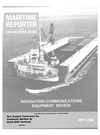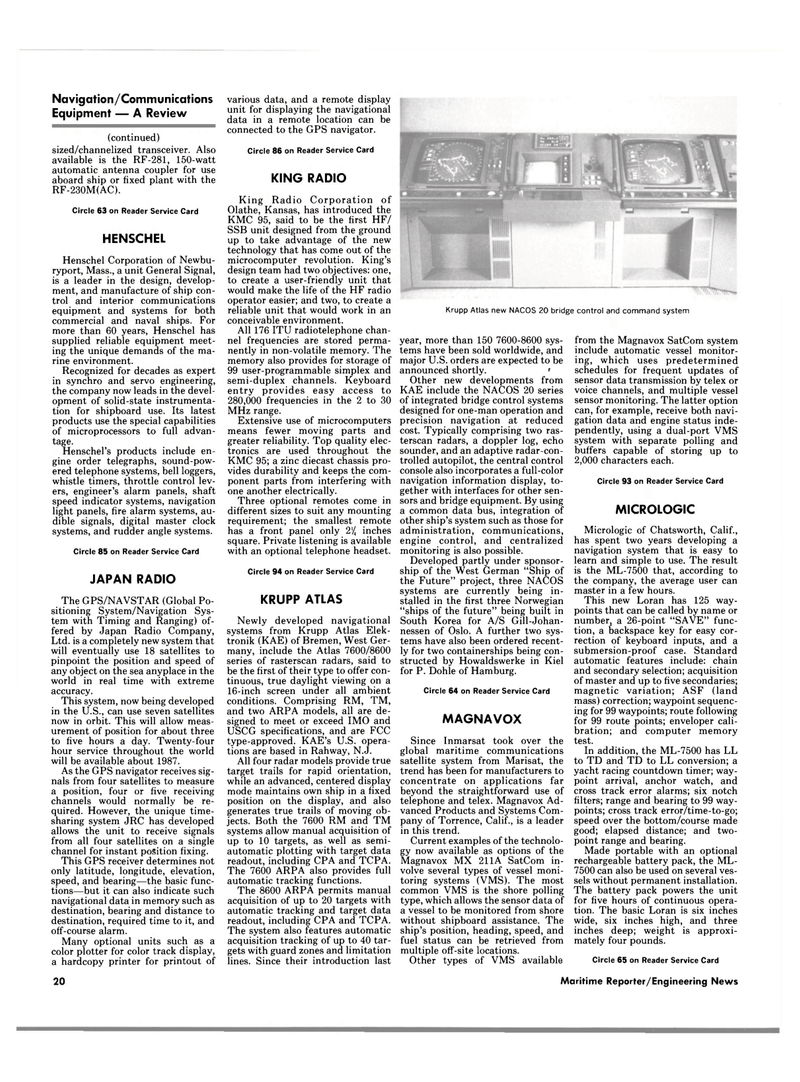
Page 18: of Maritime Reporter Magazine (May 15, 1985)
Read this page in Pdf, Flash or Html5 edition of May 15, 1985 Maritime Reporter Magazine
Navigation / Communications
Equipment — A Review (continued) sized/channelized transceiver. Also available is the RF-281, 150-watt automatic antenna coupler for use aboard ship or fixed plant with the
RF-230M(AC).
Circle 63 on Reader Service Card
HENSCHEL
Henschel Corporation of Newbu- ryport, Mass., a unit General Signal, is a leader in the design, develop- ment, and manufacture of ship con- trol and interior communications equipment and systems for both commercial and naval ships. For more than 60 years, Henschel has supplied reliable equipment meet- ing the unique demands of the ma- rine environment.
Recognized for decades as expert in synchro and servo engineering, the company now leads in the devel- opment of solid-state instrumenta- tion for shipboard use. Its latest products use the special capabilities of microprocessors to full advan- tage.
Henschel's products include en- gine order telegraphs, sound-pow- ered telephone systems, bell loggers, whistle timers, throttle control lev- ers, engineer's alarm panels, shaft speed indicator systems, navigation light panels, fire alarm systems, au- dible signals, digital master clock systems, and rudder angle systems.
Circle 85 on Reader Service Card
JAPAN RADIO
The GPS/NAVSTAR (Global Po- sitioning System/Navigation Sys- tem with Timing and Ranging) of- fered by Japan Radio Company,
Ltd. is a completely new system that will eventually use 18 satellites to pinpoint the position and speed of any object on the sea anyplace in the world in real time with extreme accuracy.
This system, now being developed in the U.S., can use seven satellites now in orbit. This will allow meas- urement of position for about three to five hours a day. Twenty-four hour service throughout the world will be available about 1987.
As the GPS navigator receives sig- nals from four satellites to measure a position, four or five receiving channels would normally be re- quired. However, the unique time- sharing system JRC has developed allows the unit to receive signals from all four satellites on a single channel for instant position fixing.
This GPS receiver determines not only latitude, longitude, elevation, speed, and bearing—the basic func- tions—but it can also indicate such navigational data in memory such as destination, bearing and distance to destination, required time to it, and off-course alarm.
Many optional units such as a color plotter for color track display, a hardcopy printer for printout of various data, and a remote display unit for displaying the navigational data in a remote location can be connected to the GPS navigator.
Circle 86 on Reader Service Card
KING RADIO
King Radio Corporation of
Olathe, Kansas, has introduced the
KMC 95, said to be the first HF/
SSB unit designed from the ground up to take advantage of the new technology that has come out of the microcomputer revolution. King's design team had two objectives: one, to create a user-friendly unit that would make the life of the HF radio operator easier; and two, to create a reliable unit that would work in an conceivable environment.
All 176 ITU radiotelephone chan- nel frequencies are stored perma- nently in non-volatile memory. The memory also provides for storage of 99 user-programmable simplex and semi-duplex channels. Keyboard entry provides easy access to 280,000 frequencies in the 2 to 30
MHz range.
Extensive use of microcomputers means fewer moving parts and greater reliability. Top quality elec- tronics are used throughout the
KMC 95; a zinc diecast chassis pro- vides durability and keeps the com- ponent parts from interfering with one another electrically.
Three optional remotes come in different sizes to suit any mounting requirement; the smallest remote has a front panel only 21/ inches square. Private listening is available with an optional telephone headset.
Circle 94 on Reader Service Card
KRUPP ATLAS
Newly developed navigational systems from Krupp Atlas Elek- tronik (KAE) of Bremen, West Ger- many, include the Atlas 7600/8600 series of rasterscan radars, said to be the first of their type to offer con- tinuous, true daylight viewing on a 16-inch screen under all ambient conditions. Comprising RM, TM, and two ARPA models, all are de- signed to meet or exceed IMO and
USCG specifications, and are FCC type-approved. KAE's U.S. opera- tions are based in Rahway, N.J.
All four radar models provide true target trails for rapid orientation, while an advanced, centered display mode maintains own ship in a fixed position on the display, and also generates true trails of moving ob- jects. Both the 7600 RM and TM systems allow manual acquisition of up to 10 targets, as well as semi- automatic plotting with target data readout, including CPA and TCPA.
The 7600 ARPA also provides full automatic tracking functions.
The 8600 ARPA permits manual acquisition of up to 20 targets with automatic tracking and target data readout, including CPA and TCPA.
The system also features automatic acquisition tracking of up to 40 tar- gets with guard zones and limitation lines. Since their introduction last
Krupp Atlas new NACOS 20 bridge control and command system year, more than 150 7600-8600 sys- tems have been sold worldwide, and major U.S. orders are expected to be announced shortly. '
Other new developments from
KAE include the NACOS 20 series of integrated bridge control systems designed for one-man operation and precision navigation at reduced cost. Typically comprising two ras- terscan radars, a doppler log, echo sounder, and an adaptive radar-con- trolled autopilot, the central control console also incorporates a full-color navigation information display, to- gether with interfaces for other sen- sors and bridge equipment. By using a common data bus, integration of other ship's system such as those for administration, communications, engine control, and centralized monitoring is also possible.
Developed partly under sponsor- ship of the West German "Ship of the Future" project, three NACOS systems are currently being in- stalled in the first three Norwegian "ships of the future" being built in
South Korea for A/S Gill-Johan- nessen of Oslo. A further two sys- tems have also been ordered recent- ly for two containerships being con- structed by Howaldswerke in Kiel for P. Dohle of Hamburg.
Circle 64 on Reader Service Card
MAGNAVOX
Since Inmarsat took over the global maritime communications satellite system from Marisat, the trend has been for manufacturers to concentrate on applications far beyond the straightforward use of telephone and telex. Magnavox Ad- vanced Products and Systems Com- pany of Torrence, Calif., is a leader in this trend.
Current examples of the technolo- gy now available as options of the
Magnavox MX 211A SatCom in- volve several types of vessel moni- toring systems (VMS). The most common VMS is the shore polling type, which allows the sensor data of a vessel to be monitored from shore without shipboard assistance. The ship's position, heading, speed, and fuel status can be retrieved from multiple off-site locations.
Other types of VMS available from the Magnavox SatCom system include automatic vessel monitor- ing, which uses predetermined schedules for frequent updates of sensor data transmission by telex or voice channels, and multiple vessel sensor monitoring. The latter option can, for example, receive both navi- gation data and engine status inde- pendently, using a dual-port VMS system with separate polling and buffers capable of storing up to 2,000 characters each.
Circle 93 on Reader Service Card
MICROLOGIC
Micrologic of Chatsworth, Calif., has spent two years developing a navigation system that is easy to learn and simple to use. The result is the ML-7500 that, according to the company, the average user can master in a few hours.
This new Loran has 125 way- points that can be called by name or number, a 26-point "SAVE" func- tion, a backspace key for easy cor- rection of keyboard inputs, and a submersion-proof case. Standard automatic features include: chain and secondary selection; acquisition of master and up to five secondaries; magnetic variation; ASF (land mass) correction; waypoint sequenc- ing for 99 waypoints; route following for 99 route points; enveloper cali- bration; and computer memory test.
In addition, the ML-7500 has LL to TD and TD to LL conversion; a yacht racing countdown timer; way- point arrival, anchor watch, and cross track error alarms; six notch filters; range and bearing to 99 way- points; cross track error/time-to-go; speed over the bottom/course made good; elapsed distance; and two- point range and bearing.
Made portable with an optional rechargeable battery pack, the ML- 7500 can also be used on several ves- sels without permanent installation.
The battery pack powers the unit for five hours of continuous opera- tion. The basic Loran is six inches wide, six inches high, and three inches deep; weight is approxi- mately four pounds.
Circle 65 on Reader Service Card 20 Maritime Reporter/Engineering News

 17
17

 19
19
